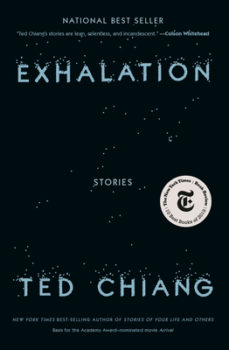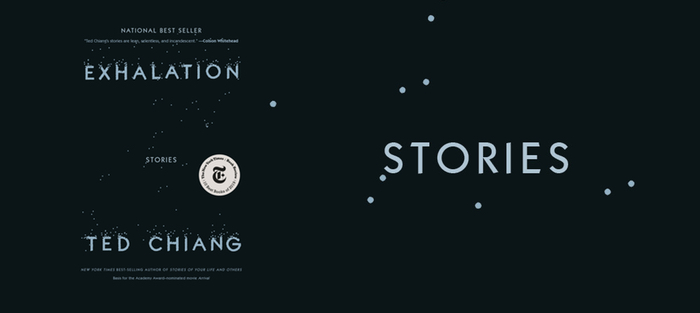Their desire to make a connection is so strong that they’ve created an ear capable of hearing across the universe.
Ted Chiang’s new book, Exhalation (Knopf), is a story collection that dwells on ruminative, universal, what-it-means-to-be-human questions and ideas. In one tale, the users of a time travel gate learn that their fates cannot be changed. In another, a device that always displays a light before you press its button renders people unable to speak or move due to the concrete demonstration that there is no free will. The collection continues the intellectual thought and emotional work of Chiang’s earlier collection, Arrival (née Stories of Your Life and Others before the movie), in which the main character in the title story learns an alien language that reveals her bittersweet, inexorable future. So, naturally, the story I have chosen to write about is the one narrated by a parrot. Bear with me, though, as even in a five-to-six-page fiction that could have easily come off as an also-ran or filler, Chiang seeks and hits depth. “The Great Silence” delivers big ideas and meets many of the same basic goals of fiction that the seventy-five-page story in the collection does.
But I and my fellow parrots are right here.
The first section of the piece opens with the declaration of the premise and the presentation of two simple, direct questions (“Why aren’t they interested in listening to our voices?” and “Aren’t we exactly what the humans are looking for?”), which is what many of Chiang’s stories do, even when there are no question marks. He lays out the premise and introduces the characters: people use the Arecibo telescope in Puerto Rico to listen for other species that can communicate, despite the fact that there is one that can do so in the forest right outside. Here’s your idea, here’s your narrator, and here is your setting. We begin.
It makes sense to remain quiet and avoid attracting attention.
When I write about an author’s work, I invariably find lines that function equally as metaphors for the author’s style. While explaining the Fermi paradox (which is the conundrum that although the universe is old and large enough that humans should’ve encountered aliens, they haven’t), the parrot says it makes sense that intelligent life would stay quiet to avoid the attention of a species known to cause extinction. Chiang’s prose, while often beautiful, is quiet, methodical, and patient, even though the stories have premises that sound flashy when summarized. This is the language of an author carefully and calmly elucidating an idea. It makes sense to write like this, as anything else might draw attention from the weight of the point.
The universe ought to be a cacophony of voices, but instead it is disconcertingly quiet.
After the prose, the next key to how Chiang’s stories so effectively explore ideas is that they’re told by or centered on the right person with the right stake in the matter, someone whose story gets at the heart of the premise. In the third section of the piece, the parrot provides another name for the Fermi paradox, the Great Silence, and presents another possible answer to the riddle: maybe everyone else is quiet because they’re already dead. Even when the narrator is an animal, Chiang picks the right animal. Who better to comment on the great silence of the universe than a member of a species whose existence relies on the ability to clearly call to one another across the din?
We don’t simply cry out. We pronounce. We enunciate.
“The peculiar problem of the short story writer is how to make the action he describes reveal as much of the mystery of existence as possible,” Flannery O’Connor said in “Writing Short Stories.” The fiction writer’s job, from this point of view, is not to answer questions but to surround them with the concrete reality of characters and details and plot, thereby approaching a truth that cannot be directly touched. “The Great Silence” is maybe not a good example of this, given that it is full of direct statements and devoid of narrative, but it does reveal deeper meaning. This concept of revealing the mystery is the literary equivalent of the scientific method, wherein each experiment has a hypothesis and tests it and collectively all the experiments of the community work together to attempt to prove any resulting theory within a reasonable margin of doubt.
“The Great Silence” is told in twelve short sections, each of which presents another mystery and tests another hypothesis. It’s as if Chiang has placed twelve facets of his central premise on the sides of a regular dodecahedron and handed it to the reader, allowing them to examine each of its flat faces until they have considered it from all its angles and thereby have a better sense of its whole. In the first four sections, the parrot presents the premise, then one answer, then another, then an example in the form of Alex, an African grey who demonstrated to humans that parrots understand abstract concepts like shape and color. In the following four sections, the parrot explains parrots’ unique contact calls and compares them to the message sent out with Arecibo, describes how parrots and humans are unique in their shared ability to learn vocally, empathizes with humans’ inability to recognize parrots’ intelligence given that parrots thought human weren’t bright for a long time, and finally presents the linguistic point that “aspiration” means both hope and breathing and that the words we speak are a sharing of both our ideas and our life force.
It’s so primal and visceral that, throughout their history, humans have considered the activity a pathway to the divine.
In the next three sections of the piece, Chiang deploys another of the elements that make his stories and ideas so powerful and meaningful: he lifts the human and scientific into the realm of faith and myth. The parrot lists the devout uses of speech—chants and mantras and speaking in tongues—and says that “Only a species of vocal learners would ascribe such importance to sound in their mythologies.” Following this catalog, the parrot describes the Hindu concept that the universe was created with the sound “om” and how that runs parallel to the Big Bang and the sound that the Arecibo picks up when it is pointed between stars. After these human beliefs, we learn that parrots have their own simple myths that are at risk of dying out with them. We do not learn what these myths are. Maybe Chiang thought that any myth he presented could come across as cheesy, insignificant, or at least underwhelming. Or, maybe the fact that we don’t get to learn them is a part of his point.
You be good. I love you.
I love “The Great Silence” because it is the odd bird out, or, to double down and use another cliché, the canary in the literary coal mine of the collection that warns us that we might all be doomed if we don’t listen. In the story notes at the end of the book, we learn that the piece was written to accompany an art exhibit by Allora & Calzadilla, in which video and audio of the telescope and forest are juxtaposed and subtitled with Chiang’s text. Although it was written as subtitles, it stands on its own and demonstrates how you can explore large ideas in fiction.
 The last section of the piece ends with a direct address, just as six of the other eight stories in the collection do, to a caliph, to an explorer happening upon the remains of a dead mechanic society, to the reader, to God. It’s a final fling outward and upward to whoever might be listening, and it elevates the story into beauty. It’s like the summarizing of a case presented by an attorney in a movie, an epic oration rarely witnessed in the wilds of real life. The parrot says that they don’t blame the humans for causing their extinction, “They just weren’t paying attention.” It’s that same bitter truth that we get in the stories with human narrators and characters, that sad realization of something undebatable about fate. There is not happiness here, but there is the aesthetic enjoyment of a story well-ended that amplifies the sadness of the message and gives us a little joy in the face of an incomprehensible, incredible, inconsiderate, and irreconcilable truth. In a final message to humanity, the parrot repeats the words that the African grey, Alex, said to the researcher the night before that parrot’s death: “You be good. I love you.”
The last section of the piece ends with a direct address, just as six of the other eight stories in the collection do, to a caliph, to an explorer happening upon the remains of a dead mechanic society, to the reader, to God. It’s a final fling outward and upward to whoever might be listening, and it elevates the story into beauty. It’s like the summarizing of a case presented by an attorney in a movie, an epic oration rarely witnessed in the wilds of real life. The parrot says that they don’t blame the humans for causing their extinction, “They just weren’t paying attention.” It’s that same bitter truth that we get in the stories with human narrators and characters, that sad realization of something undebatable about fate. There is not happiness here, but there is the aesthetic enjoyment of a story well-ended that amplifies the sadness of the message and gives us a little joy in the face of an incomprehensible, incredible, inconsiderate, and irreconcilable truth. In a final message to humanity, the parrot repeats the words that the African grey, Alex, said to the researcher the night before that parrot’s death: “You be good. I love you.”






